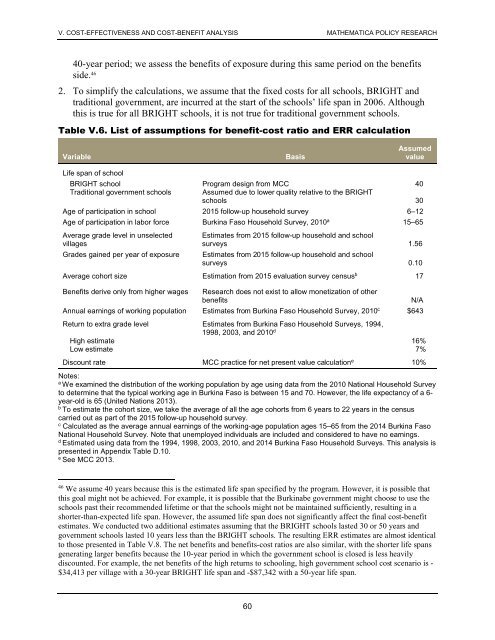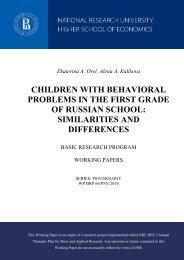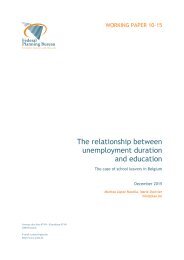Ten-Year Impacts of Burkina Faso’s BRIGHT Program
n?u=RePEc:mpr:mprres:2ecdd42bb503422b802ce20da2bf64b7&r=edu
n?u=RePEc:mpr:mprres:2ecdd42bb503422b802ce20da2bf64b7&r=edu
Create successful ePaper yourself
Turn your PDF publications into a flip-book with our unique Google optimized e-Paper software.
V. COST-EFFECTIVENESS AND COST-BENEFIT ANALYSIS MATHEMATICA POLICY RESEARCH<br />
40-year period; we assess the benefits <strong>of</strong> exposure during this same period on the benefits<br />
side. 46<br />
2. To simplify the calculations, we assume that the fixed costs for all schools, <strong>BRIGHT</strong> and<br />
traditional government, are incurred at the start <strong>of</strong> the schools’ life span in 2006. Although<br />
this is true for all <strong>BRIGHT</strong> schools, it is not true for traditional government schools.<br />
Table V.6. List <strong>of</strong> assumptions for benefit-cost ratio and ERR calculation<br />
Variable<br />
Basis<br />
Assumed<br />
value<br />
Life span <strong>of</strong> school<br />
<strong>BRIGHT</strong> school <strong>Program</strong> design from MCC 40<br />
Traditional government schools Assumed due to lower quality relative to the <strong>BRIGHT</strong><br />
schools 30<br />
Age <strong>of</strong> participation in school 2015 follow-up household survey 6–12<br />
Age <strong>of</strong> participation in labor force <strong>Burkina</strong> Faso Household Survey, 2010 a 15–65<br />
Average grade level in unselected<br />
villages<br />
Grades gained per year <strong>of</strong> exposure<br />
Estimates from 2015 follow-up household and school<br />
surveys 1.56<br />
Estimates from 2015 follow-up household and school<br />
surveys 0.10<br />
Average cohort size Estimation from 2015 evaluation survey census b 17<br />
Benefits derive only from higher wages<br />
Research does not exist to allow monetization <strong>of</strong> other<br />
benefits<br />
Annual earnings <strong>of</strong> working population Estimates from <strong>Burkina</strong> Faso Household Survey, 2010 c $643<br />
Return to extra grade level Estimates from <strong>Burkina</strong> Faso Household Surveys, 1994,<br />
1998, 2003, and 2010 d<br />
High estimate 16%<br />
Low estimate 7%<br />
Discount rate MCC practice for net present value calculation e 10%<br />
Notes:<br />
a<br />
We examined the distribution <strong>of</strong> the working population by age using data from the 2010 National Household Survey<br />
to determine that the typical working age in <strong>Burkina</strong> Faso is between 15 and 70. However, the life expectancy <strong>of</strong> a 6-<br />
year-old is 65 (United Nations 2013).<br />
b<br />
To estimate the cohort size, we take the average <strong>of</strong> all the age cohorts from 6 years to 22 years in the census<br />
carried out as part <strong>of</strong> the 2015 follow-up household survey.<br />
c<br />
Calculated as the average annual earnings <strong>of</strong> the working-age population ages 15–65 from the 2014 <strong>Burkina</strong> Faso<br />
National Household Survey. Note that unemployed individuals are included and considered to have no earnings.<br />
d<br />
Estimated using data from the 1994, 1998, 2003, 2010, and 2014 <strong>Burkina</strong> Faso Household Surveys. This analysis is<br />
presented in Appendix Table D.10.<br />
e<br />
See MCC 2013.<br />
N/A<br />
46<br />
We assume 40 years because this is the estimated life span specified by the program. However, it is possible that<br />
this goal might not be achieved. For example, it is possible that the <strong>Burkina</strong>be government might choose to use the<br />
schools past their recommended lifetime or that the schools might not be maintained sufficiently, resulting in a<br />
shorter-than-expected life span. However, the assumed life span does not significantly affect the final cost-benefit<br />
estimates. We conducted two additional estimates assuming that the <strong>BRIGHT</strong> schools lasted 30 or 50 years and<br />
government schools lasted 10 years less than the <strong>BRIGHT</strong> schools. The resulting ERR estimates are almost identical<br />
to those presented in Table V.8. The net benefits and benefits-cost ratios are also similar, with the shorter life spans<br />
generating larger benefits because the 10-year period in which the government school is closed is less heavily<br />
discounted. For example, the net benefits <strong>of</strong> the high returns to schooling, high government school cost scenario is -<br />
$34,413 per village with a 30-year <strong>BRIGHT</strong> life span and -$87,342 with a 50-year life span.<br />
60







